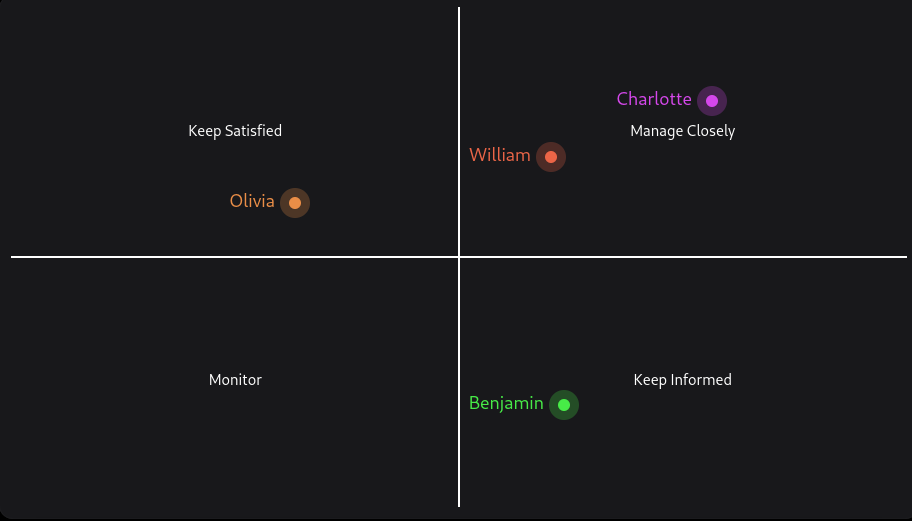Stakeholder Matrix
Improve Stakeholder Analysis with Modern Tools
Business Tools
In the dynamic landscape of project management, successful execution hinges on understanding and effectively managing stakeholder relationships. Stakeholders—individuals or groups with vested interests in a project—can significantly impact its outcome. Whether they are sponsors, team members, customers, or regulatory bodies, their influence and interest levels vary. Enter the Stakeholder Matrix Generator—a powerful tool designed to simplify stakeholder analysis and enhance decision-making.
What Is Stakeholder Analysis?
Stakeholder analysis is the process of identifying, assessing, and prioritizing stakeholders based on their influence and interest in a project. By mapping stakeholders, project managers gain insights into their needs, expectations, and potential impact. Traditionally, this analysis involves creating a stakeholder matrix, where stakeholders are plotted on a grid based on their power (influence) and interest (engagement).
The Traditional Approach
In the past, project managers manually constructed stakeholder matrices using spreadsheets or diagrams. While effective, this approach had limitations:
- Time-Consuming: Manually inputting stakeholder data and adjusting positions on the matrix was labor-intensive.
- Static: Traditional matrices lacked interactivity, making it challenging to update and adapt as stakeholder dynamics changed.
- Limited Insights: Basic matrices provided a snapshot but lacked deeper insights for strategic decision-making.
Conducting a Stakeholder analysis
Conducting a stakeholder analysis is a pivotal step in ensuring the success of any project. This strategic process involves three fundamental steps, each contributing to a deeper understanding of the individuals and entities impacted by your endeavors. Let’s delve into these steps to unlock their full potential:
Step 1: Identifying Your Stakeholders
Initiate your stakeholder analysis by meticulously identifying all parties influenced by your work. This encompasses individuals, groups, or organizations with a vested interest, power, or influence over your project’s outcomes. From your immediate supervisor to prospective customers and the wider community, compile a comprehensive list to ensure no stakeholder is overlooked.
Step 2: Prioritizing Your Stakeholders
With your stakeholders identified, prioritize them based on their power and interest in your project. Utilize a Power/Interest Grid to classify stakeholders into categories:
- High power, highly interested (Manage Closely)
- High power, less interested (Keep Satisfied)
- Low power, highly interested (Keep Informed)
- Low power, less interested (Monitor)
By understanding where each stakeholder lies on this grid, you can tailor your engagement strategies accordingly, allocating resources efficiently and effectively.
Step 3: Understanding Your Key Stakeholders
To garner support and navigate potential challenges, delve deeper into the psyche of your key stakeholders. Pose pertinent questions to discern their motivations, interests, and potential influencers. By understanding their perspectives, you can tailor communication strategies to resonate with their needs and concerns.
Furthermore, employ a color-coding system to visually represent stakeholder support levels, distinguishing advocates from critics and neutrals. This aids in strategizing efforts, focusing resources where they are most needed, and mitigating opposition effectively.
Introducing the Stakeholder Matrix Generator
The Stakeholder Matrix Generator changes the status quo by combining user-friendly design with cutting-edge technology. Here’s how it works:
- Interactive Interface: Users can easily add stakeholders, assign attributes (such as power and interest), and visualize their positions on the matrix. Drag-and-drop functionality ensures a seamless experience.
- AI Integration: The future of the Stakeholder Matrix Generator lies in AI.
- Predictive Insights: AI algorithms analyze historical data and stakeholder behavior to predict future trends. Project managers receive proactive recommendations.
- Risk Assessment: AI assesses risks associated with stakeholder engagement. It identifies potential conflicts, communication gaps, and areas needing attention.
- Scenario Modeling: Simulate different scenarios—such as changes in stakeholder priorities or external factors—to evaluate their impact on the project.
Benefits of the Stakeholder Matrix Generator
- Efficiency: Save time and effort by automating stakeholder mapping.
- Precision: Accurately position stakeholders based on their actual influence and interest.
- Strategic Decision-Making: AI-driven insights empower project managers to make informed choices.
- Collaboration: Share dynamic matrices with team members, fostering collaboration and alignment.

Conclusion
The Stakeholder Matrix Generator transcends traditional boundaries, empowering project managers to navigate the stakeholder landscape with finesse. As AI continues to shape the future of project management, this tool promises to be an indispensable asset. So, embrace the leap into the future—unlock the power of stakeholder analysis with the Stakeholder Matrix Generator! 🚀🔍